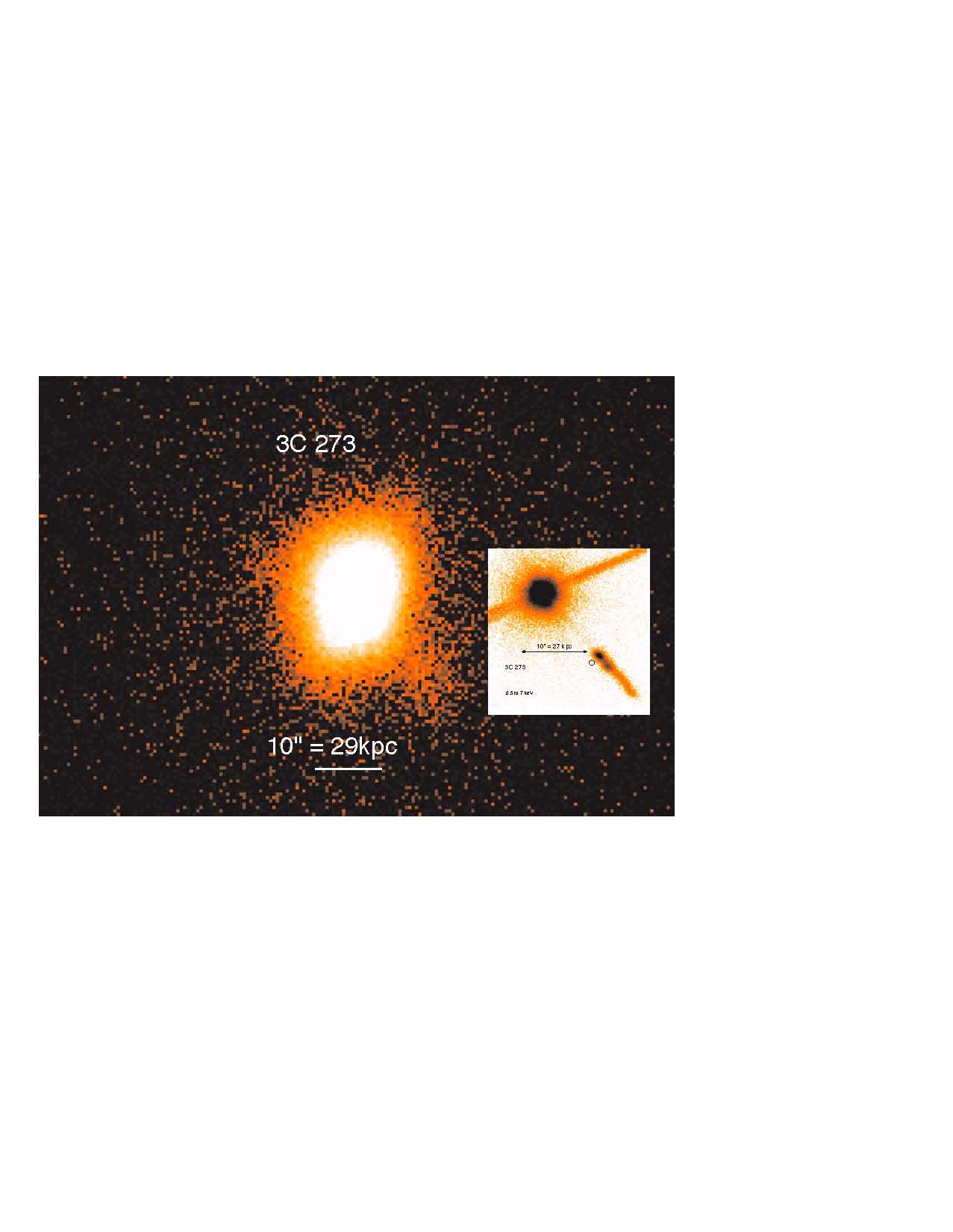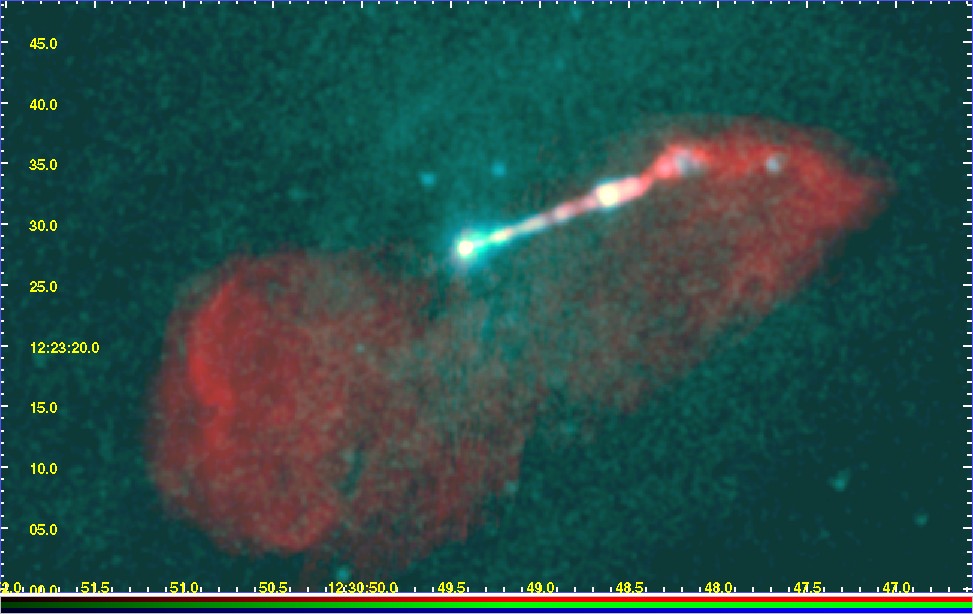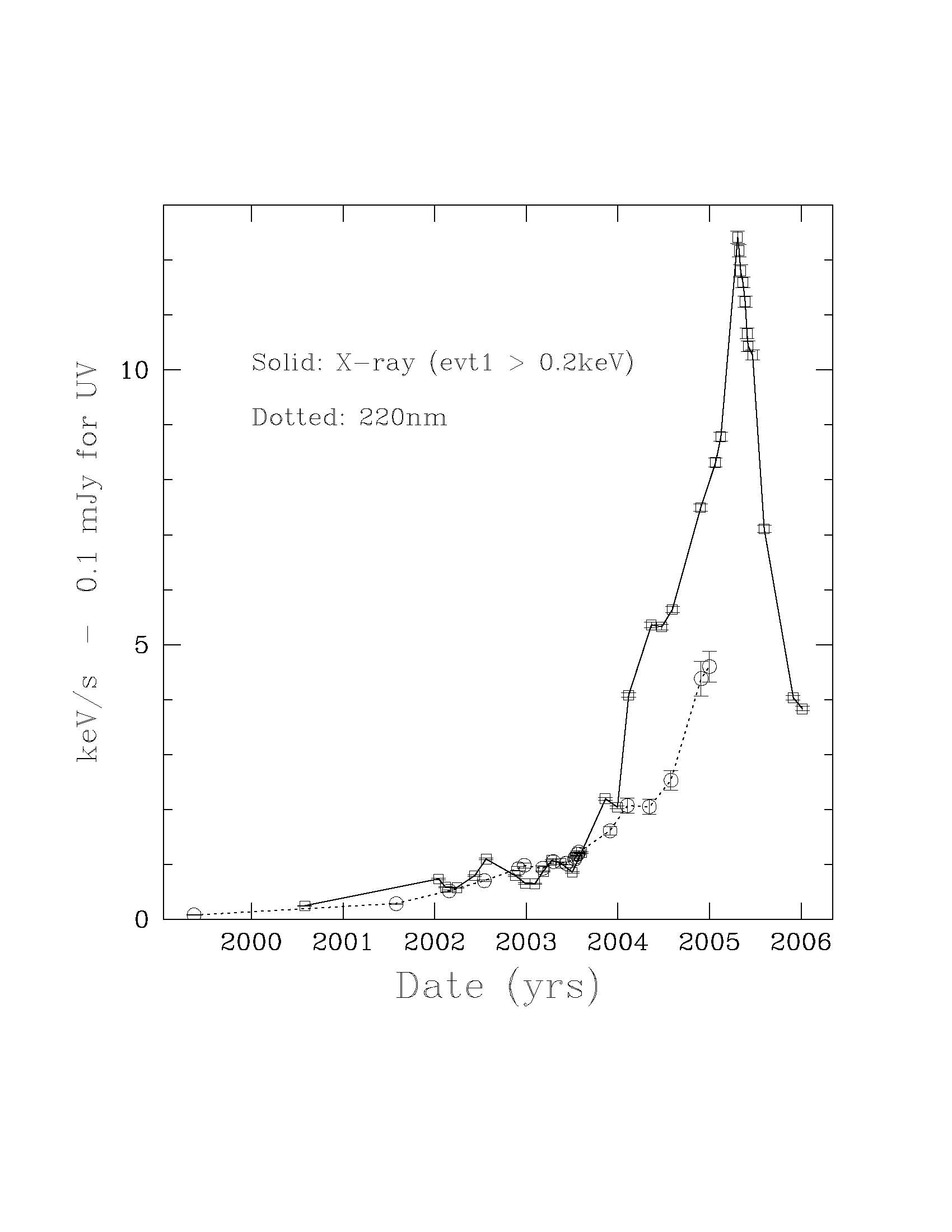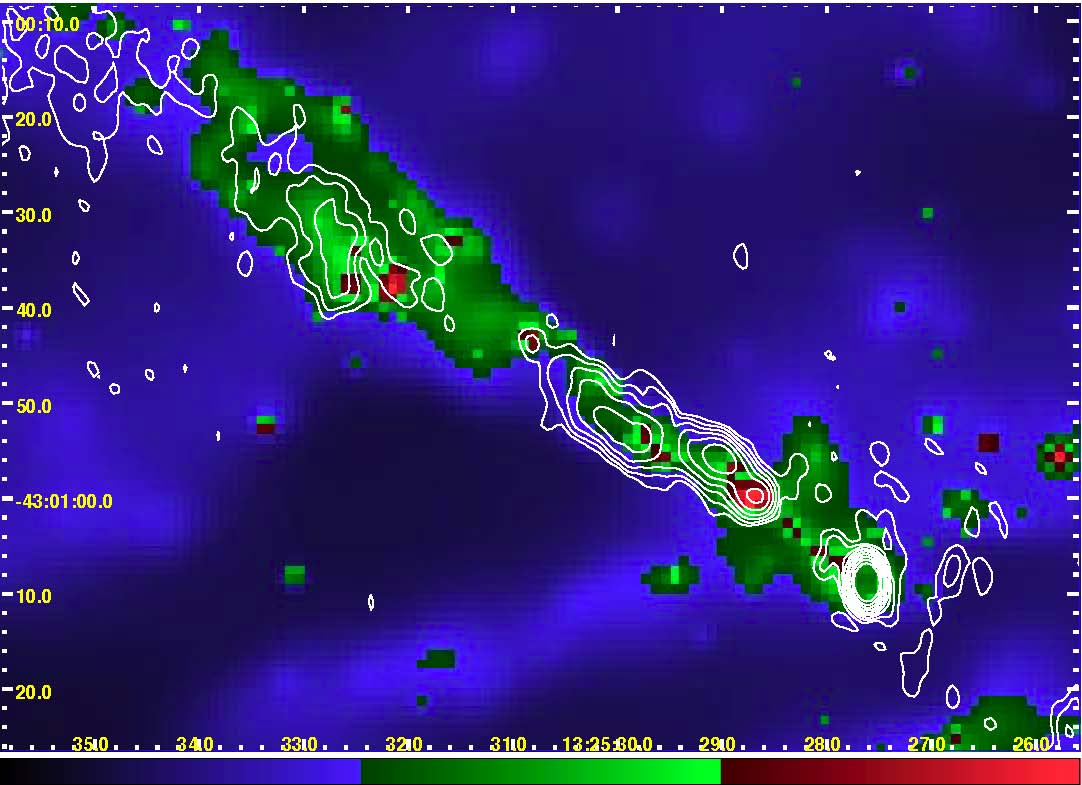

 |  |
| FIGURE 1: ROSAT (left) and Chandra (right) images of the quasar and jet in 3C 273. Both images are to the same angular scale, showing how the smaller point spread function separates the quasar from the jet, which brightens about 10" from the core. The solid diagonal line in the Chandra image is an artifact due to the ACIS readout streak. | FIGURE 2: A composite image of the inner radio lobes and jet of M87. The red scale is from an 8 GHz VLA image and the green is from a 98ks 0.2 to 6keV Chandra image. The general green X-ray background comes from thermal X-ray emission of the hot gas pervading M87 and the Virgo cluster. |
With the launch of the Chandra Observatory, the study of X-ray jets
has developed as a new area of astronomy. Galactic X-ray jets
have been studied in the symbiotic star R Aqr; the Crab, Vela,
and several other pulsars; and the subset of X-ray binaries
known as “microquasars” (as well as in the previously known
SS 433 system). In this article we discuss only the
extragalactic jets discovered by Chandra>. These occur in
Fanaroff Riley Class I and II (FR I and FR II) radio sources and
quasars, covering a wide range of luminosities.
Why has the study of X-ray jets emerged just since the advent of Chandra? Comparison of the ROSAT and Chandra images of the nearby quasar 3C 273, shown to the same scale in Figure 1, illustrates the 100-fold increase in imaging due to the 10-fold increase in linear resolution. Chandra resolves the jet in one dimension, concentrates the photons along the jet, and clearly separates the jet from the quasar core that is 300 times more luminous.
The opening of this field of research was portended shortly after
launch when the initial focusing adjustment using what was
expected to be an unresolved quasar, PKS0637-752, showed a 10"
extension to the west (Schwartz et al. 2000, Chartas et
al. 2000). After immediate concerns that this was due to a
problem with pointing control or the aspect solution, it was
quickly realized that this "stray" emission was associated
with a radio jet, and in fact the mirror quality was so good
that the jet did not compromise the use of this target to
perform the focus adjustment!
What has drawn a cadre of
researchers to work on X-ray jets is the situation that in spite
of several decades of progress via radio observations, many of
the basic questions of extragalactic jets remain unanswered. For
example, we do not yet know the identity of the primary medium
responsible for transferring energy from the environs of the
supermassive black hole to the distant hotspots up to a Mpc
away. Contenders are normal p+/e- plasma (either "cold" or
relativistic), pair plasma, and Poynting flux. Although we are
fairly confident that jets have bulk velocities which are
relativistic because of the predominant one-sidedness, we do not
know if characteristic velocities β = v/c are of order 0.5 to
0.9, or if values of β greater than 0.99 are common. Other
features still hotly debated are how jets are launched, the
nature of jet collimation, the internal velocity structure, the
extent of entrainment and the mechanisms of deceleration.
What does the X-ray data tell us? The broad band spectral energy
distribution (SED) from radio through IR and optical and to the
X-rays, can help us deduce the emission mechanisms. Observations
of X-rays show us a population of electrons of energy much
higher or much lower (depending on the emission mechanism) than
those which produce radio emission. In this article we will see
how X-rays may be showing us the sites of particle acceleration,
allowing observation of the low end of the relativistic electron
spectrum, measuring the relativistic bulk velocities of the
jets, and may even be serving as beacons to the most distant
detectable activity in the early universe.
Many of the essential attributes of X-ray jets are illustrated in Figure 2. The non-thermal source is two sided (i.e. the two radio lobes shown in red) whereas the jet is visible on only one side, thus convincing us that relativistic beaming provides the Doppler favoritism to hide the counterjet and enhance the brightness of the jet coming towards us. Almost all of the currently known (more than 50) X-ray emitting jets are one sided. Both the unresolved nucleus of M87 (where the supermassive black hole responsible for the jets is located) and "knot A" (the bright area near the end of the straight part of the jet) are prominent in radio and X-rays. Note that the inner part of the jet has a larger ratio of X-ray to radio brightness than regions further from the nucleus, as shown by the change from white and blue to red. Such behavior is shown by many, though not all, X-ray jets.
X-ray jets are naturally divided into two classes following the radio morphology: those from FRI radio galaxies have projected sizes generally less than 10 kpc, and those from FRII radio galaxies and quasars have X-ray jet lengths usually greater than 10 kpc. The apparent X-ray luminosities also divide with FRI's mostly < 1042 erg s-1, and quasars typically > 1043 erg s-1. Part of this dichotomy can be ascribed to selection effects from finite angular resolution and from possible differences in bulk velocities between the two types of jets. There is an ever-increasing number of jet detections from the inner segments of FRI jets. They all align well with radio features, are mostly one sided, and are of low brightness, making spectral and variability studies difficult.
One problem of immediate interest to X-ray astronomers is the uncertainty as to which non-thermal emission process is responsible for the bulk of X-ray jet emission. Although there is general agreement that synchrotron emission predominates for the low power sources (FRI), the favored, but problematic, process for quasar jets is inverse Compton (IC) emission from relativistic electrons scattering photons from the cosmic microwave background (CMB) (Tavecchio et al. 2000, Celotti et al. 2001). In the following sections, we briefly give examples of nearby FRI jets, and then discuss the higher power radio sources detected by Chandra surveys of radio jets.
One of the more unexpected and spectacular jet results from Chandra data was a large flare in the knot HST-1 0.8" from the nucleus (Figure 3). The X-ray and optical lightcurves are shown in Figure 4, and details can be found in Harris et al. (2006). The lightcurve shows an overall increase of a factor of 50, and a rapid decay comparable to the rise time. At its peak, HST-1 was brighter than the core and the rest of the jet combined. Once we process optical and radio data already observed, we will be able to evaluate any time delays between bands, separate light travel time ("geometry") effects from electron energy loss time scales, and possibly distinguish between expansion losses and radiation losses and derive a new estimate of the average magnetic field strength. We have been exceedingly lucky to have Chandra's resolution for this flare; with Einstein, ROSAT, or even XMM Newton, this event would most likely have been ascribed to the SMBH neighborhood instead of 60 to 200pc (depending on the projection angle) down the jet. The important lesson is that if one is observing an outburst from a blazer, what is seen may not be coming from a region close to the accretion disk!
Centaurus AThe X-ray jet of Cen A is the closest example of an extragalactic jet and the Chandra resolution of ~1 arcsec provides a spatial resolution of 17 pc, more than a factor of 4 better than for M87. As can be seen from Figure 6, the morphology is more complex than that of M87. Recent publications by Kraft et al. (2002) and Hardcastle et al. (2003) discuss the relation of the X-ray and radio morphology. Some of the radio features in the jet have moved, and some of the X-ray features have changed their intensity.

Following the discovery of the jet in PKS 0637-752, two groups
undertook short exposure (5 to 10 ks) surveys to try to assess
the frequency of X-ray jet emission. Both were based on flat
spectrum AGN with radio jets, so one would expect that they are
biased toward objects pointed in our direction. The team led by
Rita Sambruna emphasized the coordinated search for optical
emission using the Hubble Space Telescope (Sambruna et al.;
2002, 2004, 2006). A team led by Herman Marshall emphasized
coordination with high resolution radio maps from the Australia
Telescope Compact Array (Marshall et al. 2005; Gelbord et
al. 2005; Schwartz et al. 2006). Both surveys detected jets at a
rate of about 60%, and due to the short exposures it is
reasonable to expect that the non-detections could be
intrisically similar but with a smaller ratio of X-ray to radio
luminosity. Where X-ray emission is detected in jets, the
radiated X-ray power, νfν, exceeds that of the radio, which is
a selection effect due to the X-ray sensitivity of the short
observations. Figure 5, prepared by Herman Marshall and
Jonathan Gelbord, shows a montage of 20 of the 22 jets detected
in their survey of 37 quasars.
A key conclusion of both studies was that the SED did not allow
an extrapolation of the radio spectrum through the optical and
to the X-ray, even if one includes a high energy break due to
loss mechanisms. So a single population of relativistic
electrons could not be producing the X-ray emission via
synchrotron emission. Yet, if the region emitting the radio
synchrotron radiation were anywhere near the minimum energy
condition (which is nearly equivalent to equipartition of energy
between magnetic fields and relativistic particles), then there
were not enough electrons to produce the X-rays via inverse
Compton emission off of any possible photon source. The
breakthrough idea by Tavecchio et al. (2000) and Celotti et
al. (2001) noted that if the jet was in relativistic motion then
the CMB photon density would be enhanced in the rest frame of
the jet by the square of the bulk Lorentz factor. In this case,
the lowest energy X-rays detected by Chandra imply that the
electron spectrum extends down to a minimum energy at least as
low as Lorentz factors of 50, if the jet bulk motion has Lorentz
factor 10, or below 500 if the jet is not
in relativistic motion.


With those assumptions and interpretations, one can calculate the
rest frame magnetic field and the Doppler factor from spatially
resolved elements along the jets. The numerical accuracy is
limited by the many assumptions, including setting the Doppler
factor equal to the Lorentz factor, but still restricts
quantities to an allowed range of about a factor of
two. Typically one finds magnetic fields in the range 5 to 25
micro-Gauss, and Doppler factors from 3 to 15. One can go on to
calculate the maximum angle by which the jets could deviate from
our line of sight to be in the range 4° to 20°, and hence from
their measured angles on the sky we deduce their intrinsic
lengths extend at least up to the order of a few million light
years.

Once we know the magnetic field and relativistic velocity, we can
estimate the kinetic energy flux being transported out to those
millions of light years. The calculation gives fluxes of at
least 1045.5 to 1047.5 ergs s-1. These are often comparable to
or in excess of the bolometric, isotropic radiation from the
quasar itself. Such large energy transport, which must originate
at the quasar black hole center, has important implications for
the accretion mechanism and therefore the rate at which black
holes might form in the early universe. Also, when such jets
occur in clusters of galaxies they provide more than enough
energy to power the cavities which have been revealed by Chandra
observations, and to stop the cooling flow of cluster
gas.
Is inverse Compton scattering on the CMB really the mechanism of
X-ray jet emission? Although it is the simplest modification to
producing the entire SED via synchrotron emission from a single
particle population, adding only one parameter, many authors
have shown that more complex sub-structure or additional
electron populations, could be constructed to emit the
X-rays. Indeed, in the case of the nearest object, Cen A, and
the brightest quasar jet, 3C 273, there is clear evidence of
spatial inhomogeneity and of independent electron
populations.
Perhaps the most serious mystery for any mechanism is how the
relative ratio of X-ray to radio emission is often constant,
within a factor less than 2, along tens to hundreds of kpc of
the jet. X-ray synchrotron emitting electrons have lifetimes at
most tens of years, so there would have to be a delicate
re-acceleration balance. Compton X-ray and radio synchrotron
emitting electrons differ in energy by only two orders of
magnitude, so in the inverse Compton CMB scenario it may be much
more natural to maintain a contant emission ratio. However, that
would still require the assumption that the magnetic field
remains relatively constant along the jet. Basically we know
that if the bulk Lorentz factor of the jet is 3 to 15, the
emission of X-rays is likely to be via IC/CMB since the CMB
energy density will exceed that of the magnetic field energy
density. Furthermore we know the jets in bulk relativistic
motion from observations of one-sidedness and superluminal
expansion in the AGN cores. So it may boil down to determining
exactly what is the distribution of bulk Lorentz factors
displayed by quasars and where does deceleration of the jet
occur.
It is most exciting to pursue the IC/CMB hypothesis because of the remarkable prediction that such an X-ray jet would maintain a nearly constant surface brightness no matter how far distant it is. This is because the IC emission depends on the energy density of the CMB photons, and that density increases with redshift z as (1+z)4, offsetting exactly (except for a bandwidth, or "K-correction", term) the (1+z)-4 cosmological diminution of surface brightness. In fact, this guarantees that at some redshift, which may be modest values of 2 to 4 for jets already observed, the IC/CMB mechanism must come to dominate. Therefore, current observational capabilities would allow us to detect X-ray jets at whatever large redshift they first form!